Car scratches and scrapes originate from all different sources. If you drive your vehicle on a daily basis, it’s almost inevitable that your finish will get blemished in some way. What’s more important is what you can do about it when or if it happens.
The products and procedures outlined below are designed to help you repair and enhance your vehicle inexpensively yourself with great results.
There are a number of different techniques and methods to repair scratches, scrapes and scuffs in your vehicle. The repair process, tools and materials required for each of the methods or projects below are clearly identified. The amount of time and effort really depends on the type of scratch or scuff that you have. Scratch repair procedures below fall into two categories:
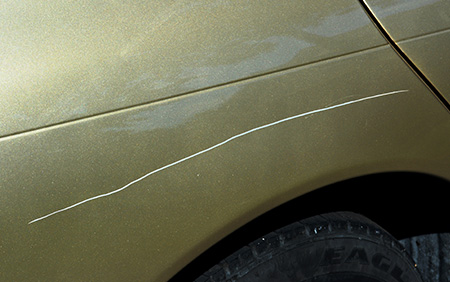
Click Below for Step-by-Step Instructions – Four Methods on How to Repair a Car Scratches
1. Minor Scratches: scratches/scuffs that can be removed with Compounding or Clear Coat Pen.
Minor Scratch Repair: Method One (Light Sanding and Compounding)
The first step in repairing minor scratches or scrapes is understanding the extent of the damage. If the scratches or scrapes are not deep they should be easily removed with rubbing compound and/or light sanding and compounding. Try using rubbing compound first to remove scratches before you begin sanding. If you can run your fingernail across the scratch without catching the nail on the scratch, the scratch has probably not penetrated the clearcoat very far (see Illustration 1-1), and can be removed without repainting.
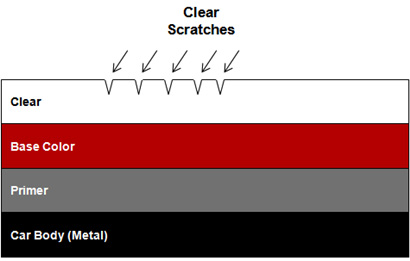
Step 1 – Use Rubbing Compound on Scratch
- Before sanding, try using Rubbing Compound on a clean Applicator Pad to remove the scratch. An aggressive Rubbing Compound can remove a lot of surface defects and scratches.
- If scratch cannot be removed using only Rubbing Compound, then use the 3M-Scratch-Removal-System Kit to complete the removal of the scratch.
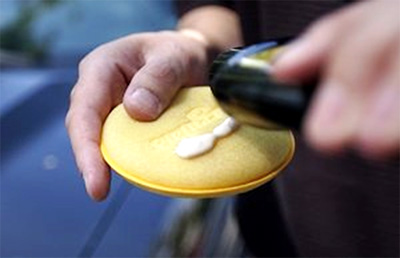
Step 2 – Spray Area with Water, Wet Sand, Dry
- Start with spraying water onto the green/gray side of the 3000 Grit Abrasive Square and onto the area to be repaired (wet sanding requires water).
- Use the 3000 Grit Abrasive Square to wet sand the area of the scratch, working in no more than a 4 x 4 inch section.
- Use light to medium pressure.
- A white slurry will form as you sand the scratch.
- Wipe the area frequently with a clean Disposable Towel or Rubber Squeegee to determine if the scratch has been removed.
- Check your work often. Look at the area from all angles to make sure the scratch has been removed.
- Continue to wet sand using water and the 3000 Grit Abrasive Square until the scratch is gone (take caution not to sand through the clearcoat).
- Wipe the area with a clean, dry Disposable Towel.
Helpful Tip: When wet sanding by hand, use a Plastic Spray Bottle filled with clean water to help keep the area lubricated with water while sanding.
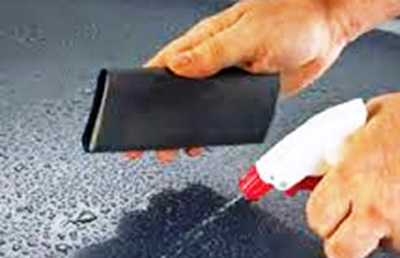
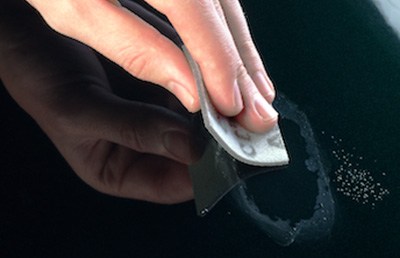
Step 3 – Get Ready to Polish – Attach Disc Pad Holder
- Attach the 3 Inch Disc Pad Holder onto your Drill.
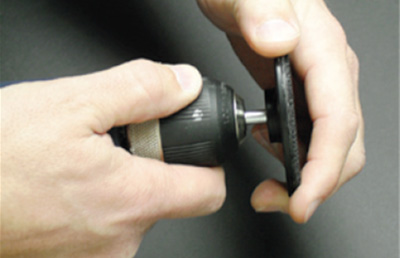
Step 4 – Attach Purple Compounding Pad
- Attach and center the Purple Compounding Pad onto the Disc Pad Holder.
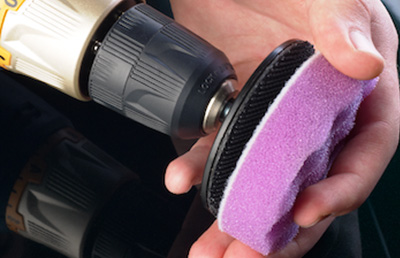
Step 5 – Apply Rubbing Compound
- Squeeze a quarter-sized amount of Rubbing Compound onto the Purple Compounding Pad.
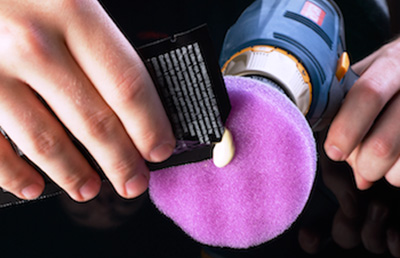
Step 6 – Spread Rubbing Compound and Buff
- Smear the compound over the work area before turning on the Drill.
- Buff at light to medium pressure, extending the buffing area about a pad width beyond the repair spot.
- Buff in up and down, side to side motions.
Helpful Tip: Use caution when buffing around door handles and at the edges of panels where paint may be thinner. You can use Tape to mask off and protect these areas when buffing.
- Reduce pressure as the compound dries.
- Repeat this step if any sanding scratches are still visible.
- Wipe the area with a clean, dry Disposable Towel.
- The Purple Compounding Pad can be rinsed out with water and reused.
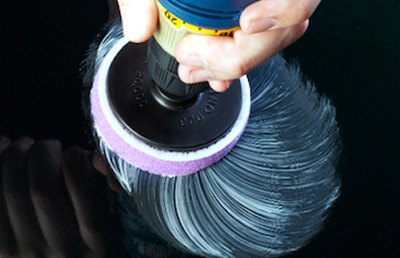
Step 7 – Replace Purple Compounding Pad with Black Polishing Pad
- Remove the Purple Compounding Pad from the Disc Pad Holder and replace it with the Black Polishing Pad.
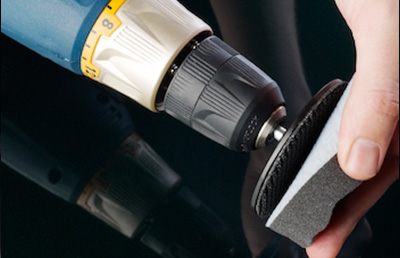
Step 8 – Apply Polishing Compound (Scratch Remover)
- Squeeze a quarter-size amount of Scratch Remover onto the pad.
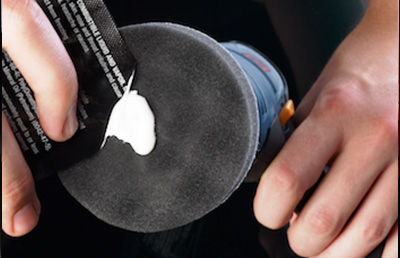
Step 9 – Spread Polishing Compound and Polish
- Spread the polish over the repair area with the Drill turned off.
- Polish the repair area using light to medium pressure at a comfortable Drill
- You only need to apply enough pressure to compress the surface of the waffle pad.
- Work in side to side, up and down motions until the entire area is polished.
- Reduce pressure as the polish dries and desired shine is achieved.
- Repeat application if necessary. Buff by hand with a clean, dry microfiber towel.
- The Black Polishing Pad can be rinsed out with water and reserved for future use.
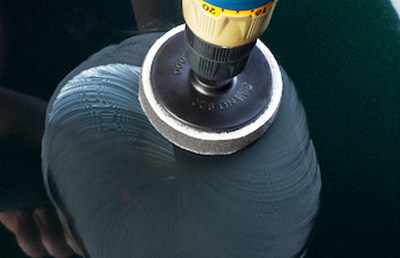
Step 10 – Protect the Repair Area
- Once you have polished out the scratch, apply Synthetic Wax to the repaired area and the rest of the vehicle for added protection.
See Also: Detailing & Polishing
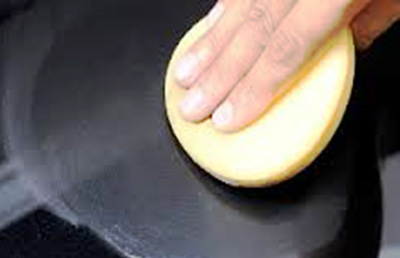
Minor Scratch Repair: Method Two (Clear Coat Pen)
If the scratches or scrapes have not penetrated the clearcoat (see Illustration 1-2), you can use a Clear Coat Pen to help fill in and hide the scratch versus sanding and compounding. A Clear Coat Pen is easy to use and offers a quick way to help hide the scratch. A Clear Coat Pen can also be used as a sealer on deeper scratches that do penetrate the clearcoat and color to help seal and protect the metal from deterioration and rust.
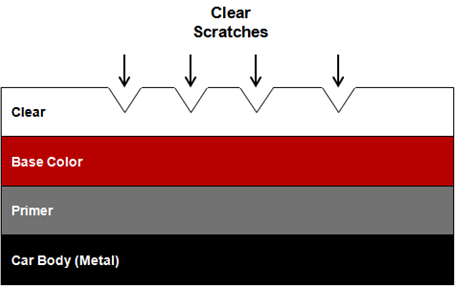
Step 1 – Access the Scratch
- If scratch is only in the clear coat of the vehicle it will sometimes look simply like a white line.
- If the scratch has not penetrated the clear, you can fix very easily with a Clear Coat Pen.
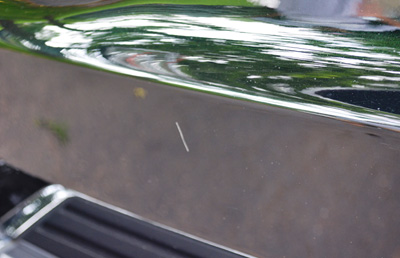
Step 2 – Prepare the Clear Coat Pen
- With the cap still on, give the Clear Coat Pen several shakes back and forth. You should be able to hear the rattle of the agitator ball inside the pen.
- To get the clear flowing in the pen, press down first on a separate piece of cardboard or firm surface other than the vehicle.
- Once the tip on the pen is saturated with clear, you are ready to apply clear to the vehicle.
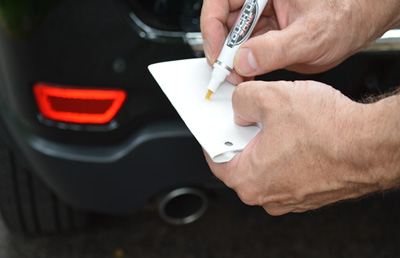
Step 3 – Apply Clear over the Scratch
- With a steady hand press down on the Clear Coat Pen applying firm but gentle pressure.
- Start at one end of the scratch and move steadily to the other end of the scratch – you should only need one coat.
Helpful Tip: You may want to practice first on a piece of cardboard or other firm surface before using on the vehicle to get a feel on the flow of the clear. The harder you press down with the pen, the higher the flow of clear from the pen.
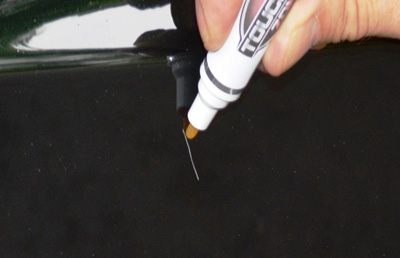
Step 4 – Let Clear Dry Overnight
- The Clear Coat Pen dries quickly to a high gloss and does not need polishing, but if you do plan on waxing or polishing the vehicle let the clear air dry overnight.
- If you did apply too much clear over the scratch, you can sand and level the area with very fine 1500 Grit Wetordry Sand Paper and water, or with a Hand Sanding Cylinder and 1500 Grit Wetordry Sanding Circle (pictured right). This micro nibber / sander works great for very precise sanding and finishing work.
- After sanding flat, use Rubbing Compound and Polishing Compound to buff to a glossy shine.
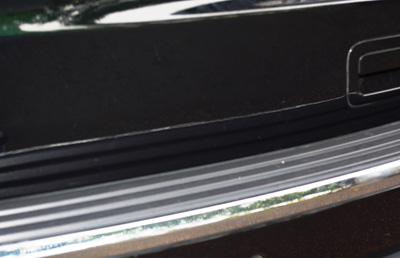
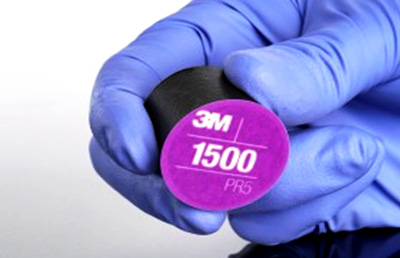
2. Major Scratches: scratches, scrapes or scuffs that require Touch Up Paint to repair.
Major Scratch Repair: Method One (Hand Application)
Major scratches or scuffs are those that penetrate through the clearcoat, color, primer and sometimes down to bare metal (see Illustration 1-3). Major scratches require replacing the color and clearcoat. If the scratch has penetrated down to bare metal, you will also have to sand and prime before refinishing with color and clear.
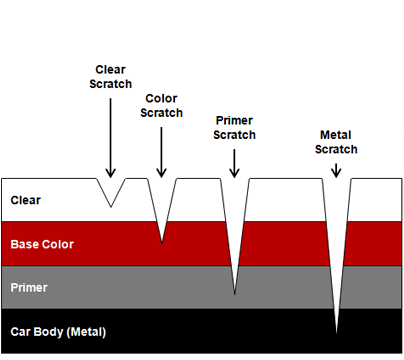
Step 2 – Access the Scratch
- If the scratch has penetrated down to the bare metal, you will need to sand the metal surface with a Prep Pen, and then apply Primer to the bare metal.
- If the scratch has begun to rust, you will need to sand away all rust, and then use a Prep Wipe to clean the area before applying Primer (Primer is available on Touch Up Zone in small bottles, pens, aerosols, as well as larger sizes).
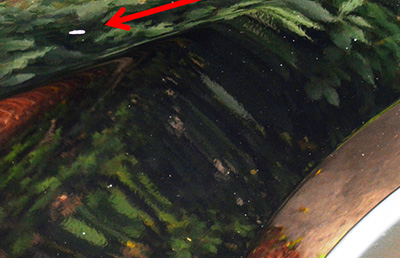
Step 3 – Fill and Apply Color to Scratch
- If the scratch has not penetrated down to bare metal, you may start to fill and level the scratch with primer, putty or paint.
- If the scratch is not too deep, apply Base Color directly to the scratch with a Touch Up Brush (pictured), Dabber, or Base Color Pen.
- Apply only enough Base Color to hide the scratch.
- Allow Base Color to dry 5 to 10 minutes (@70 degrees F or longer if using in cooler temperatures).
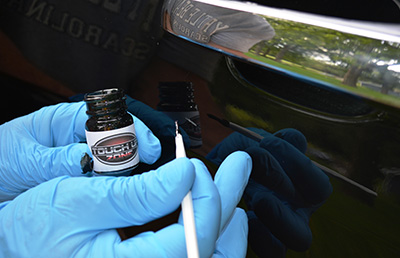
Step 4 – Apply Clear over the Scratch.
- After Base Color has dried (should be completely flat with no gloss), you are ready to apply Clear.
- Apply Clear over Base Color using a Touch Up Brush (pictured on right), Dabber, or Clear Coat Pen (see Image 1-3 below).
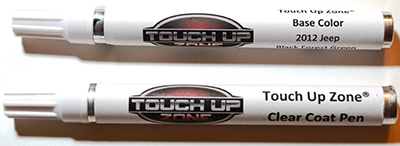
Image 1-3
Touch Up Pens (Base Color and Clear Coat Pen)
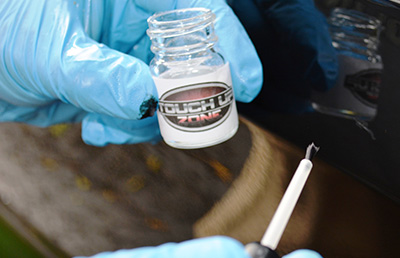
Step 5 – Level the Area (minimize any blobs)
- If there is an excessive amount of Clear over the scratched area, you can flatten the area (minimize the blob) by sanding with very fine 1500 Grit Wetordry Sand Paper and water (pictured right), or with a Hand Sanding Cylinder and 1500 Grit Wetordry Sanding Circle (pictured right). This micro nibber / sander works great for very precise sanding and finishing work.
- After sanding flat, use Rubbing Compound and Polishing Compound to buff to a glossy shine.
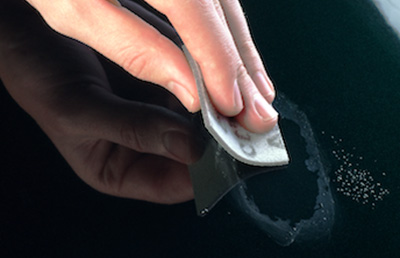
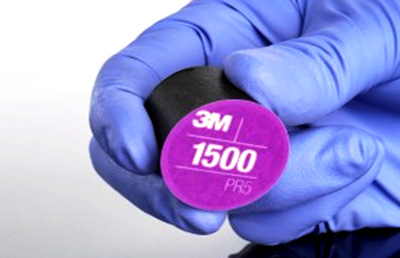
Step 6 – Let Clear Dry Overnight
- Once you are satisfied with the scratch repair, let the Clear dry overnight.
- You can polish or wax the area the next day.
- The Base Color and Clear touch up are designed to hide scratches in your vehicles surface. The repair will most likely not be completely invisible from close up, but you should not be able to detect the repair from normal viewing distance.
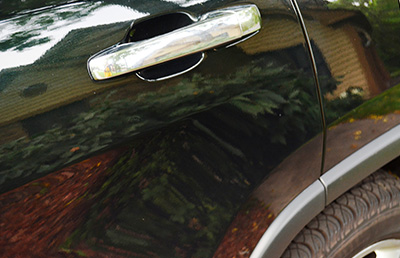
Major Scratch Repair: Method Two (Spray Application)
Major scratches or scuffs are those that penetrate through the clearcoat, color, primer and sometimes down to bare metal (see Illustration 1-4). Major scratches require replacing the color and clear. If the scratch has penetrated down to bare metal, you will also have to sand and prime before refinishing with color and clear.
Major scratch repair Method Two requires the use of an air assisted spray device to apply primer, color and clear (Spray Gun, Air Brush, Aerosol Can, Preval Sprayer or Spra Tool). Using spray equipment to apply Base Color and Clear provides the most effective method in delivering an invisible repair. Most professional paint technicians use this method for fixing scratches and other cosmetic damage.
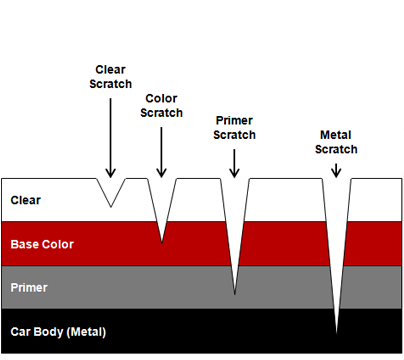
Step 2 – Assess the Scratch
- Assess the scratch to determine how far it has penetrated the surface.
- If the scratch has penetrated down to bare metal, you will have take a couple extra steps before applying color and clear.
- Sand the metal lightly with a Prep Pen to make sure the metal surface is clean and free of any rust.
- Use a Prep Wipe to clean the surface and eliminate any contamination.
- Apply Primer to the bare metal to help fill the scratch, provide rust
protection, and provide proper adhesion of the Base Color and Clear.
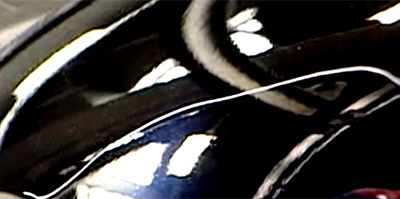
Step 3 – Fine Sand the Scratch Area
- Using a Drill or Mini Orbital Sander (requires air compressor), 3 Inch Velcro Sanding Pad attachment and a 1000 Grit 3 Inch Sanding Disc, sand the scratch area leveling the scratch and preparing the area around the scratch for blending.
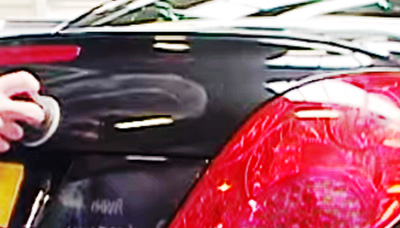
Step 4 – Wipe Down and Mask Area
- Clean the area after sanding.
- Use a Prep Wipe to remove any contaminants before painting.
- Dry the area with a clean cloth.
- Mask off any areas where paint or overspray may land on with Tape and Masking Paper.
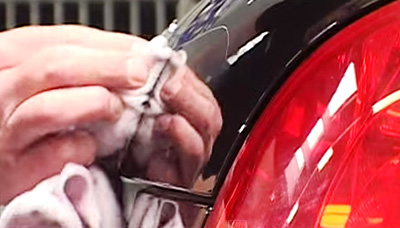
Step 5 – Spray Base Color and Clear
- Using an Air Brush (or Spray Gun, Detail Gun, Preval Sprayer, or Spra Tool), apply Base Color lightly over scratch.
- Apply 2 to 3 coats of Base Color or until you have complete coverage and hiding of scratch.
- Try to spray only the scratch itself, tapering out each coat very narrowly to confine the area where paint is being applied.
- Allow a 3 to 5 minute flash between each coat of Base Color.
Helpful Tip: Choose spray equipment that provides good atomization of the Base Color and Clear. Less expensive spray equipment will sometimes atomize poorly and end up spitting out paint particles onto the vehicle. Good spray equipment will atomize and break up the Base Color and Clear into finer particles that flow very nicely onto the surface. This makes it easier to blend into the existing paint finish.
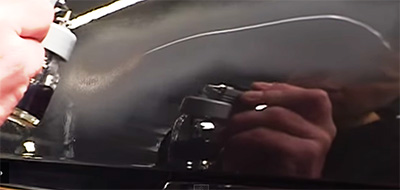
Step 6 – Use Blender on Edges
- After the Base Color and Clear have been applied, very quickly spray Edge Blender lightly over the edges of the spray area.
- This will help melt in the edge of the blend area.
Helpful Tip: It is very useful to use two separate guns for the final blending operation. One Spray Gun (or Air Brush) will be filled with Clear and the second Spray Gun (or Air Brush) will be filled with Edge Blender. As you put spray the last coat of Clear, have the second Spray Gun (or Air Brush) filled with Edge Blender so you can pick up the second Spray Gun (or Air Brush) and start spraying the edges of the Clear with Edge Blender. If the Clear dries before you spray Edge Blender over the edges, it will be more difficult to melt the edges into the blend area.
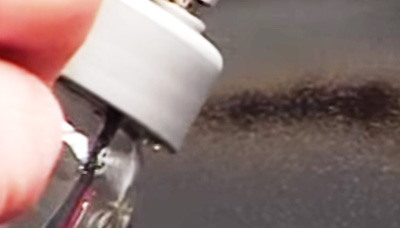
Step 7 – Let Base Color and Clear Dry
- After spraying Base Color, Clear, and Edge Blender, allow to dry at least two hours at 70 degrees F.
Helpful Tip: You can accelerate drying if you have a Heat Lamp that you can place 2 to 3 feet from the repair. The direct heat from the lamp will speed the overall curing process.
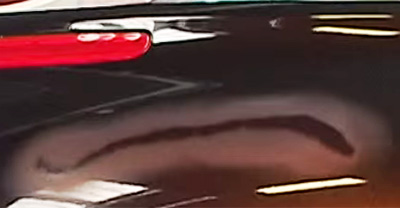
Step 8 – West Sand with Fine Sand Paper
- After spraying Base Color, Clear, and Edge Blender, allow to dry at least two hours at 70 degrees F.
Helpful Tip: You can accelerate drying if you have a Heat Lamp that you can place 2 to 3 feet from the repair. The direct heat from the lamp will speed the overall curing process.
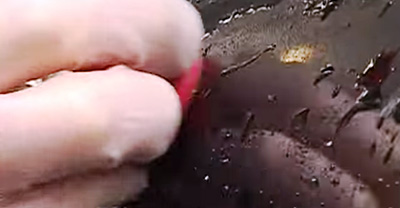
Step 9 – Buff the Repair Area
- Using a Drill or Mini Orbital Sander (requires air compressor), Purple Compounding Pad, and Rubbing Compound, buff the area to remove sanding scratches and to buff out the edge of the blend area.
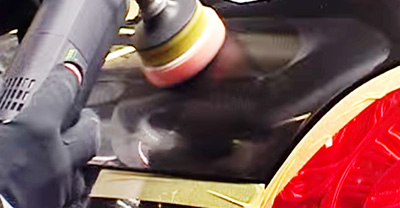
Step 10 – Polish the Repair Area
- Replace the Purple Compounding Pad with a Black Polishing Pad. Apply Polishing Compound and polish area to a high gloss. The Polishing Compound will also eliminate any remaining fine sanding scratches.
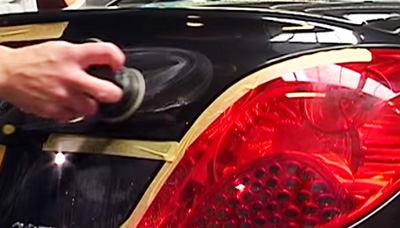
Step 11 – Protect the Repair Area
- Once you have polished to a high gloss, apply Synthetic Wax to the repaired area and the rest of the vehicle for added protection.
See Also: Detailing & Polishing

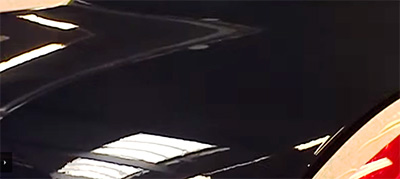
Please be Advised
The recommendations and process steps listed in the projects below are general do-it-yourself recommendations that are designed to produce a successful project. Due to the many variables involved with each project and process steps, Touch Up Zone cannot guarantee results and does not accept liability for incorrect product application or use.
Before you Start
- Always wear proper safety protection: Safety Glasses, Respirator, Particle Mask, Latex or Nitrile Gloves and Hearing Protection (if you are using power tools that emit high noise levels).
- Utilize a well ventilated area when spraying coatings or sanding.
- Make sure the temperature is warm enough to allow coatings and materials to dry properly.
- Work in a well lighted area where you can clearly see what you are doing.
- Always follow label instructions on products.
Tools, Equipment, Paint and Material Options
The Tools, Equipment, Paint and Materials recommended for the each project are listed in the repair procedure and are highlighted in Red. You can purchase the Tools, Equipment, Paint and Materials for these products by clicking on the button below. For product definitions and general tech tips click here.


